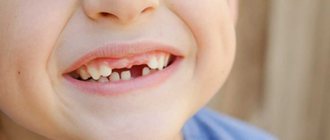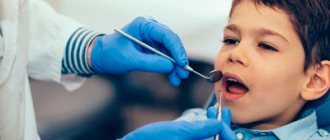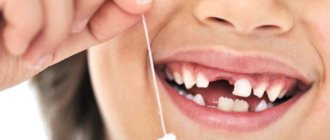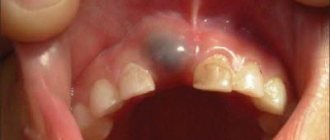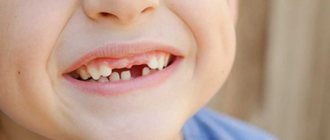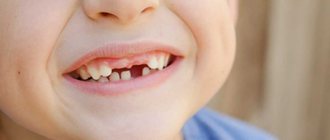Features of the period.
During this period, the formation and further development of the roots of baby teeth occurs: they are strengthened in the bone tissue of the jaws. The processes of root formation smoothly flow into the processes of their resorption and replacement with permanent teeth, the rudiments of which are located under the milk teeth.
The presence of interdental spaces between the incisors and canines of the upper and lower jaws is a sign of a “normal” correctly developing occlusion of primary teeth. The absence of interdental spaces in the primary dentition indirectly indicates a lack of space for the eruption of permanent incisors and canines, the crowns of which are significantly wider.
PHOTO: Teeth of a 3-year-old child. By the age of 3, a child already has a full set of teeth in his mouth. There should be spaces between baby teeth.
Starting from 5-6 years of age, the bite of temporary (baby) teeth is replaced with permanent ones. This is preceded by the growth of the rudiments of permanent teeth and the physiological resorption of the roots of milk teeth. As the roots of baby teeth are reabsorbed, mobility of these teeth appears. At this age, parents often note mobility of the lower and upper front teeth (deciduous incisors). When the root is completely absorbed, the tooth may fall out on its own: sometimes children “help” the tooth fall out with their tongue, constantly rocking it. Sometimes the “loss” of a resorbed tooth occurs while eating or playing.
Closer to 6 years, the first permanent chewing tooth (first molar) erupts behind the last milk tooth. The eruption of the first permanent molar is not accompanied by the loss of any tooth and does not cause any discomfort to the child, so it often goes unnoticed.
Parents often take the first permanent chewing tooth for additional milk, as it bursts behind all the milk teeth and this does not precede the loss of the milk tooth: it seems that the child has 24 malate tooth.
PHOTO: Milk teeth in children aged 6 years. The lower lateral incisors fell out. Soon permanent lateral incisors will appear in their place.
Approximate timing of eruption of permanent teeth in children of preschool and school age
- home
- To our clients
- Articles for parents
- Questions for a specialist
- Approximate timing of eruption of permanent teeth in children of preschool and school age
>
>
>
>
The timing of teething can characterize both the biological and passport age of the child. The process and timing of teething depend not only on inherited genetic parameters. But the timing of teething can be influenced by external and internal factors. For example: climatic conditions, diet, quality of drinking water, etc. In this regard, the timing of the eruption of permanent teeth varies in different regions. During a person’s life, 20 teeth once, and the remaining 8-12 teeth do not change; they erupt initially as permanent teeth (molars).
By the age of three, all teeth erupt , which by the age of 5 begin to gradually be replaced by permanent ones .
An adult normally has 28-32 permanent teeth : on each jaw there are 4 incisors, 2 canines , 4 premolars and 4-6 molars . The development of the third molar (“wisdom tooth”) may not occur at all, with congenital edentia of the third molars , which is also considered normal. Another situation is also possible: a wisdom tooth This situation occurs very often.
general opinion about the normal timing of the eruption of permanent teeth , since scientific studies by different authors were carried out in different regions and in different years of the last and present centuries.
Thus, there is an approximate sequence of normal eruption of permanent teeth :
1 First molars (“sixth teeth”)
2 Central incisors
3 Lateral incisors
4 First premolars (“fourth teeth”)
5 Canines (“eye teeth”) and/or second premolars (“fifth teeth”)
6 Second molars (“seventh teeth”)
7 Third molars (“wisdom teeth”)
Important! Each baby tooth is normally loosened and replaced with a permanent one:
Central primary incisor on the permanent one of the same name
Lateral primary incisor on the permanent one of the same name
Milk canine to permanent canine of the same name
First primary molar to first permanent premolar ("fourth tooth")
Second primary molar to second permanent premolar ("fifth tooth")
The first permanent molar (“sixth tooth”) appears immediately permanent at 5-7 years of age
The second permanent molar (“seventh tooth”) appears immediately permanent at 9-12 years of age
| Eruption stage | Central incisor | Lateral incisor | Fang | 1st premolar | 2nd premolar | 1st molar | 2nd molar |
| Boys | |||||||
| Start | 5,8-6,0 | 6,0-6,2 | 9,5 | 8,5 | 8,5 | 5,5 | 10,5 |
| Average terms | 6,5-6,7 | 7,3 | 10,5 | 9,5 | 11,5 | 6,5 | 12,5 |
| Ending | 7,5 | 8,0 | 12,5 | 11,0 | 12,5 | 7,5 | 13,0 |
| Girls | |||||||
| Start | 5,5-7,5 | 6,0 | 9,5 | 8,5 | 8,5 | 5,5 | 10,5 |
| Average terms | 6,0-6,2 | 7,0 | 10,5 | 9,0 | 11,0 | 6,0 | 12,0 |
| Ending | 7,5 | 8,0 | 12,5 | 10,0 | 12,0 | 7,5 | 12,5 |
Local pediatrician: A reference guide/Ed. M. F. Rzyankina, V. P. Molochny
Typical problems.
The most typical problem between the ages of 3 and 6 years is the development of caries of primary teeth in the area of the first and second primary molars. The narrow interdental spaces between the first and second primary molars, which are difficult for a child to reach, are an ideal place for plaque to accumulate. As a result, caries forms on the surface of the teeth hidden from the eyes of parents (between the 4th and 5th milk teeth). Being unnoticed, the carious process quickly progresses, complicated by inflammation of the nerve of the tooth (pulpitis).
With poor oral hygiene and a large number of carious teeth, caries of the permanent molar (6th tooth) often develops, high-quality treatment of which is only possible by a pediatric dentist.
When does a baby's first teeth erupt?
All babies cut their teeth according to their own individual program: for some this process begins earlier, for others later. As practice shows, most children have their first tooth between the ages of 6 and 8.5 months, and by the age of one year, every healthy child has at least one baby tooth in their mouth.
At the age of three to four months, the teeth that are preparing to erupt begin to make themselves known quite actively: the baby becomes capricious, cries, and tries to bite everything that falls into his hands.
The very first to appear are usually the two lower ones, located in the center of the tooth (lower central incisors or “ones”). Then - the central upper incisors, followed by approximately ten months of age, the upper “twos”, or lateral upper incisors, erupt. By eleven to twelve months, the lateral incisors can be seen on the lower jaw. Thus, ideally, a one-year-old child is the happy owner of eight baby teeth.
By about sixteen months, many babies already have their first molars at the bottom and top. Fangs (“threes”) appear above and below later, in the eighteenth to twenty-second months of a child’s life. The upper and lower second molars erupt between 24 and 33 months of age. But again, it should be remembered that this process is individual and the order of teething may also be different.
Often teeth grow in pairs: two, and sometimes four at a time. Girls generally erupt teeth earlier than boys. By the age of 2.5-3 years, a child can find a full set of twenty fully erupted teeth.
Caution must be exercised if a child who is almost one year old does not have a single tooth. In principle, some children may have a congenital feature in the form of late teething, but you should not draw any conclusions on your own; you should definitely consult with a qualified specialist who, if necessary, will prescribe additional examinations.
Causes of late teething in children:
- hereditary predisposition, which is a variant of the norm and can be traced in other blood relatives;
- decreased thyroid function;
- rickets;
- diseases of the digestive system;
- disorders of enzymatic (fermentation) metabolism;
- pituitary insufficiency;
- lack of calcium in the child’s body;
- genetically determined diseases.
For the baby himself, the process of teething can proceed in different ways. Some children experience virtually no discomfort, others suffer from pain, their sleep is disturbed, their appetite worsens, their temperature rises (up to 38-39̊C), salivation increases, they may experience nasal congestion, a wet cough (due to excessive salivation), constipation, or, conversely, , increased bowel movements.
Experts recommend starting to care for your child’s oral cavity even before the first teeth erupt: in the morning and evening, before going to bed at night, the child’s gums should be carefully wiped with a swab previously moistened with warm water. After the first teeth appear, you need to clean them with a special finger brush, which can also be used to massage the gum tissue. The front teeth should be brushed with vertical movements, the side teeth should be brushed in a circular motion.
The Healthy Smile network of dental clinics employs experienced pediatric dentists, with whom you can schedule your child for a free consultation.
The Healthy Smile clinics provide discounts for regular customers, family discounts, various payment methods are possible, and the list of promotional offers to reduce the cost of certain types of services, including for children, is regularly updated.
How does the growth process of molars occur?
At 12-13 years of age, a child, as a rule, no longer has milk teeth, although their roots dissolve earlier. At this point, there are part of the molars in the mouth with fully and partially formed roots.
Dental roots go through 2 stages in their development:
- the period of unformed apex (the root is still as long as possible, the walls are parallel, the canal is wide);
- the stage of an unclosed apex (the formation of the apex ends, the walls of the canal come closer together).
The roots of the lower jaw form faster than the upper jaw. This process also has approximate deadlines, but they can shift in both directions. Therefore, it is definitely impossible to answer the question at what age children develop permanent teeth - canines, incisors or molars. As with dairy products, everything is individual here.
Formation of permanent bite
The development of molars in children begins in the prenatal period and lasts until 18–20 years, when their structure fully corresponds to “adult” parameters. That is why their condition, as well as the exact timing of eruption, depend on many factors. This:
- genetic predisposition, which is associated with metabolic characteristics;
- insufficient consumption of mineral elements in food, and we are talking about the nutrition of not only the child, but also the woman during pregnancy;
- fluoride deficiency in water and food;
- compliance with hygiene rules;
- some infectious diseases suffered by the mother (during gestation);
- insufficient functional activity of the salivary glands, since saliva contains certain substances that additionally provide mineralization of enamel, etc.
How does teething occur?
With the exception of rare cases of congenital or acquired pathologies, the appearance of molars coincides with the time of loss of milk teeth. Usually, part of the permanent tooth is already visible in this place; sometimes its growth is delayed for a short time, which is also one of the normal options.
Contrary to popular belief, temporary teeth have roots, and they differ in shape and structure from permanent ones: they can be curved and “sit” quite deeply in the gums. But as the child grows up and the rudiments of the molars grow, the “temporary” roots gradually dissolve and on an x-ray they look “eaten away”, shortened.
In this case, the pulp, where the nerve endings and blood vessels are concentrated, is replaced by granular tissue, which also participates in the resorption of the “milky” root system. And if depulpation (nerve removal) was previously performed due to injury or advanced caries, this process occurs faster.
Content:
- Formation of permanent bite:
- Eruption of permanent teeth in children: timing and features:
- Features of care.
1.1. How does eruption occur?
2.1. Approximate timing of bite change. 2.2. Associated symptoms.
Until recently, dentists, like pediatricians, were quite strict about the time frame for the eruption of molars in children. In accordance with generally accepted standards, this process begins at 6 years and ends by 12–13 years. But as clinical data accumulates, experts are increasingly inclined to believe that such terms are quite arbitrary, that is, they are observed in most children, and deviations from the norm are not always a sign of a disease or some kind of developmental disorder.
